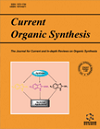- Home
- A-Z Publications
- Current Organic Synthesis
- Previous Issues
- Volume 16, Issue 6, 2019
Current Organic Synthesis - Volume 16, Issue 6, 2019
Volume 16, Issue 6, 2019
-
-
Advances in the Chemistry of 6-6 Bicyclic Systems: Chemistry of Pyrido[3,4-d]pyrimidines
More LessAuthors: Mohamed Monier, Doaa Abdel-Latif, Ahmed El-Mekabaty, Başak D. Mert and Khaled M. ElattarThe aim of this work is to discuss the chemistry of pyrido[3,4-d]pyrimidines as one of the most important heterocyclic compounds with remarkable synthetic, biological and medical applications. In this overview, the chemistry of heterocyclic compounds incorporated the pyrido[3,4-d]pyrimidine scaffold as demonstrated by chemical reactions and different preparation processes. The anticipated compounds were synthesized fro Read More
-
-
-
Multicomponent Reactions for the Synthesis of Bioactive Compounds: A Review
More LessAuthors: Cedric S. Graebin, Felipe V. Ribeiro, Kamilla R. Rogério and Arthur E. KümmerleMulticomponent reactions (MCRs) are composed of three or more reagents in which the final product has all or most of the carbon atoms from its starting materials. These reactions represent, in the medicinal chemistry context, great potential in the research for new bioactive compounds, since their products can present great structural complexity. The aim of this review is to present the main multicomponent reactions sin Read More
-
-
-
A Novel Series of N-aryltriazole and N-acridinyltriazole Hybrids as Potential Anticancer Agents
More LessAuthors: Charles K. Rono, James Darkwa, Debra Meyer and Banothile C.E. MakhubelaBackground: Triazoles are a class of aza-heterocycles with broad spectrum of biological importance. The synthetic tunability of the triazole moiety allows for the development of new pharmacophores with applications as drugs to contend with the burden of cancer. Objective: In this study, we aimed to develop a series of N-aryltriazole and N-acridinyltriazole molecular hybrids and evaluate their potential as anticancer agents. M Read More
-
-
-
Hafnium(IV) Chloride Catalyzes Highly Efficient Acetalization of Carbonyl Compounds
More LessBackground: Hafnium(IV) tetrachloride efficiently catalyzes the protection of a variety of aldehydes and ketones, including benzophenone, acetophenone, and cyclohexanone, to the corresponding dimethyl acetals and 1,3-dioxolanes, under microwave heating. Substrates possessing acid-labile protecting groups (TBDPS and Boc) chemoselectively generated the corresponding acetal/ketal in excellent yields. Aims and Read More
-
-
-
Novel Heterocyclic Hybrids Based on 2-Pyrazoline: Synthesis and Assessment of Anti-Inflammatory and Analgesic Activities
More LessAuthors: Ahmed A.O. Abeed, Gehad A.A. Jaleel and Mohamed S.K. YoussefAim and Objective: A series of new 2-pyrazoline analogues were synthesized. The structures of the synthesized compounds were elucidated by the analytical and spectroscopic data. Some selected compounds were screened for the anti-inflammatory activity by using animal model of carrageenan-induced paw edema in mice. Additionally, the analgesic and acute toxicity of these compounds were evaluated and exhibit Read More
-
-
-
Heteroaromatization with 4-Phenyldiazenyl-1-naphthol. Part IV: Synthesis of Some New Heterocyclic Compounds with Potential Biological Activity
More LessAuthors: Hany M. Mohamed and Ashraf H.F. Abd El-WahabBackground: Synthetic azo compounds and their derivatives have been studied extensively due to their biological and pharmacological activities. Pyranopyridines, pyranopyrimidines and tetrazoles derivatives have emerged as a promising and attractive scaffold in the development of potent biological and pharmacological agents. Objectives: To design a series of new benzochromeno(pyridine/pyrimidine/tetrazole) derivatives a Read More
-
-
-
The Immobilized Copper on Nickel Ferrite: A Magnetically Superior Nanocatalyst for Chemoselective and Knoevenagel Synthesis of Bisdimedones and 1,8-Dioxo-octahydroxanthenes under Solvent-Free Conditions
More LessAuthors: Behzad Zeynizadeh, Soleiman Rahmani and Arezu HallajAim and Objective: Nowadays, bisdimedones and 1,8-dioxo-octahydroxanthenes are considered as biologically active materials. Due to this, the synthesis of the mentioned materials is the subject of more interest. Although most of the reported methods have their own merits, however, they generally require the use of expensive reagents, hazardous organic solvents, a tedious workup procedure and reduced recyclability of t Read More
-
Volumes & issues
-
Volume 22 (2025)
-
Volume 21 (2024)
-
Volume 20 (2023)
-
Volume 19 (2022)
-
Volume 18 (2021)
-
Volume 17 (2020)
-
Volume 16 (2019)
-
Volume 15 (2018)
-
Volume 14 (2017)
-
Volume 13 (2016)
-
Volume 12 (2015)
-
Volume 11 (2014)
-
Volume 10 (2013)
-
Volume 9 (2012)
-
Volume 8 (2011)
-
Volume 7 (2010)
-
Volume 6 (2009)
-
Volume 5 (2008)
-
Volume 4 (2007)
-
Volume 3 (2006)
-
Volume 2 (2005)
-
Volume 1 (2004)
Most Read This Month
Article
content/journals/cos
Journal
10
5
false
en


